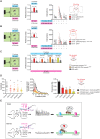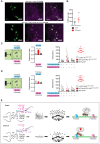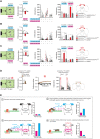A neural circuit linking two sugar sensors regulates satiety-dependent fructose drive in Drosophila
- PMID: 34851668
- PMCID: PMC8635442
- DOI: 10.1126/sciadv.abj0186
A neural circuit linking two sugar sensors regulates satiety-dependent fructose drive in Drosophila
Abstract
In flies, neuronal sensors detect prandial changes in circulating fructose levels and either sustain or terminate feeding, depending on internal state. Here, we describe a three-part neural circuit that imparts satiety-dependent modulation of fructose sensing. We show that dorsal fan-shaped body neurons display oscillatory calcium activity when hemolymph glucose is high and that these oscillations require glutamatergic input from SLP-AB or “Janus” neurons projecting from the protocerebrum to the asymmetric body. Suppression of activity in this circuit, either by starvation or by genetic silencing, promotes specific drive for fructose ingestion. This is achieved through neuropeptidergic signaling by tachykinin, which is released from the fan-shaped body when glycemia is high. Tachykinin, in turn, signals to Gr43a-positive fructose sensors to modulate their response to fructose. Together, our results demonstrate how a three-layer neural circuit links the detection of two sugars to produce precise satiety-dependent control of feeding behavior.
Figures








Similar articles
-
A fructose receptor functions as a nutrient sensor in the Drosophila brain.Cell. 2012 Nov 21;151(5):1113-25. doi: 10.1016/j.cell.2012.10.024. Cell. 2012. PMID: 23178127 Free PMC article.
-
A novel satiety sensor detects circulating glucose and suppresses food consumption via insulin-producing cells in Drosophila.Cell Res. 2021 May;31(5):580-588. doi: 10.1038/s41422-020-00449-7. Epub 2020 Dec 3. Cell Res. 2021. PMID: 33273704 Free PMC article.
-
Diverse roles for the Drosophila fructose sensor Gr43a.Fly (Austin). 2014;8(1):19-25. doi: 10.4161/fly.27241. Epub 2013 Nov 22. Fly (Austin). 2014. PMID: 24406333 Free PMC article.
-
Sugar consumption, metabolic disease and obesity: The state of the controversy.Crit Rev Clin Lab Sci. 2016;53(1):52-67. doi: 10.3109/10408363.2015.1084990. Epub 2015 Sep 17. Crit Rev Clin Lab Sci. 2016. PMID: 26376619 Free PMC article. Review.
-
Dietary sugars: their detection by the gut-brain axis and their peripheral and central effects in health and diseases.Eur J Nutr. 2015 Feb;54(1):1-24. doi: 10.1007/s00394-014-0776-y. Epub 2014 Oct 9. Eur J Nutr. 2015. PMID: 25296886 Free PMC article. Review.
Cited by
-
Drosophila Tachykininergic Neurons Modulate the Activity of Two Groups of Receptor-Expressing Neurons to Regulate Aggressive Tone.J Neurosci. 2023 May 10;43(19):3394-3420. doi: 10.1523/JNEUROSCI.1734-22.2023. Epub 2023 Mar 28. J Neurosci. 2023. PMID: 36977580 Free PMC article.
-
Stem cell-specific ecdysone signaling regulates the development and function of a Drosophila sleep homeostat.bioRxiv [Preprint]. 2023 Oct 2:2023.09.29.560022. doi: 10.1101/2023.09.29.560022. bioRxiv. 2023. Update in: Curr Biol. 2024 Nov 4;34(21):4951-4967.e5. doi: 10.1016/j.cub.2024.09.020. PMID: 37873323 Free PMC article. Updated. Preprint.
-
Lineages to circuits: the developmental and evolutionary architecture of information channels into the central complex.J Comp Physiol A Neuroethol Sens Neural Behav Physiol. 2023 Jul;209(4):679-720. doi: 10.1007/s00359-023-01616-y. Epub 2023 Mar 17. J Comp Physiol A Neuroethol Sens Neural Behav Physiol. 2023. PMID: 36932234 Free PMC article. Review.
-
Comparative Perspectives on Neuropeptide Function and Social Isolation.Biol Psychiatry. 2025 May 15;97(10):942-952. doi: 10.1016/j.biopsych.2025.01.019. Epub 2025 Jan 30. Biol Psychiatry. 2025. PMID: 39892690 Review.
-
A brief history of insect neuropeptide and peptide hormone research.Cell Tissue Res. 2025 Feb;399(2):129-159. doi: 10.1007/s00441-024-03936-0. Epub 2024 Dec 10. Cell Tissue Res. 2025. PMID: 39653844 Free PMC article. Review.
References
-
- Payant M. A., Chee M. J., Neural mechanisms underlying the role of fructose in overfeeding. Neurosci. Biobehav. Rev. 128, 346–357 (2021). - PubMed
-
- Niwano Y., Adachi T., Kashimura J., Sakata T., Sasaki H., Sekine K., Yamamoto S., Yonekubo A., Kimura S., Is glycemic index of food a feasible predictor of appetite, hunger, and satiety? J. Nutr. Sci. Vitaminol. 55, 201–207 (2009). - PubMed
LinkOut - more resources
Full Text Sources
Molecular Biology Databases

